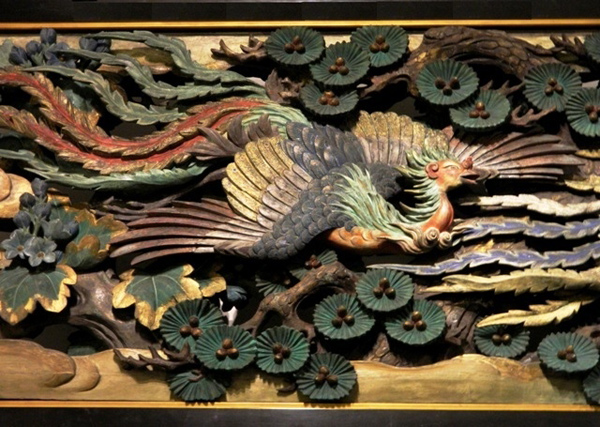Art Institute's Japanese Ramma Panels Complete a Wild Ride of Chicago History
By JoshMogerman in Arts & Entertainment on Sep 3, 2011 7:00PM

Phoenix detail from one of four ramma panels surviving the Japanese pavilion at the World Fair of 1893. [courtesy of Art Institute of Chicago]
When the Art Institute put four carved wooden architectural transoms on display last month, it marked the end of a wild Chicago history rollercoaster ride. The circuitous journey that began in the Japanese pavilion at the World’s Columbian Exposition of 1893 is yet another example of just how much sometimes has to go right for elements of this town’s architectural legacy to survive over the years. We chatted about the carved panels’ history with the Art Institute’s Roger L. Weston Associate Curator of Japanese Art Janice Katz earlier this week.
Situated on the Wooded Isle (in the lagoon behind what is now the Museum of Science and Industry), the Japanese World Fair pavilion, called the “Phoenix Hall,” was a garish counter to the rest of the White City. The transoms, called ramma, depicting the mythical birds that gave the hall its name, hung in the center of the building. Among the throngs that passed through its detail-covered interior walls was Frank Lloyd Wright, who was taken with the space’s decorative elements. After the fair, the pavilion and all its stunning decorative elements were given to Chicago, kicking off a journey which Katz says, “ran the gamut between not caring and caring too much.”
During World War II the pavilion (which had been converted into a tea house) suffered two fires, at least one an arson, and had to be demolished. The soot-covered ramma were saved by Park District personnel and stashed under the bleachers at Soldier Field. When the storage area was cleaned out decades later in 1973, the panels were sent to the Art Institute and UIC. The university’s went on display in their art history building, while the Art Institute’s went into a basement storage area.
Decades later, UIC professor David Sokol and architectural historian Keith Bringe approached the Art Institute with worries about the condition of the panels. The ramma’s wooden planks were separating and the coloring was coming off, but there was little interest in them until Katz joined the curatorial staff. When the Art Institute began planning for a renovation of its Japanese galleries the timing was right to bring all four of the transoms back together.
What followed was an arduous 10-month collaboration between the Art Institute’s objects conservators and Evanston's Litas Laparini Art Restoration to bring the pieces back. Katz says that at least one of the four panels had all of the color scrubbed off and some f the phoenix heads had broken off and needed to be re-carved. Luckily photos helped to extrapolate details and colors so that they could be brought back to look like they had “aged gracefully.”
Today, it is hard not to notice the incredible complexity and depth to the carvings, which are set in a soffitted area of the gallery. Trees and feathers fall energetically outside the frame, seemingly counter to the modern Japanese minimalism that we see today. And the ramma look unlike any architectural details we see in the west, which is perhaps the most interesting thing about the whole story. The panels are in a gray area -- they are not artworks, they were part of a building. In the end, it was an art curator, with no architectural training, who brought back these new icons of the City’s architectural history. Katz sees it differently. To her, gaggles of Chicagoans had a hand in keeping the panels alive over the last century. From that perspective, the Art Institute has given us one of the best architectural feel-good stories in years.